Belgrade hosted the last qualifier of the NextGen Euroleague, with INSEP coming out on top with an undefeated run which saw the French team qualify to the NextGen Finals. A 14-point win in the final against Milano crowned a team with so many young guys looking to break out at this level, in one of the basketball capitals of Europe. Along with the MVP Noa Kouakou-Heugue, his teammate Hugo Yimga Moukouri, Milano’s Diego Garavaglia, Joventut’s Ian Platteeuw and Next Gen Selection Belgrade’s Aaron Towo-Nansi completed the All-Tournament Five.
INSEP
INSEP emerged as champions in Belgrade after two hard-fought battles in the final stretch of the tournament. They secured the title with a convincing victory over EA7 Milano in the final. Their path to the championship was even more dramatic, as they earned their spot in the final by outlasting the NextGen Select Team in a thrilling double-overtime showdown, winning 92-85. INSEP featured some of the tournament’s most intriguing prospects, including Hugo Yimga Moukouri, Noa Kouakou-Heugue, and Nathan Soliman. Their combination of size, athleticism, and versatility made them key contributors to INSEP’s dominant run in Belgrade.
Noa Kouakou-Heugue was named MVP of the NextGen Euroleague qualifier in Belgrade after delivering an outstanding all-around performance. He averaged 15.5 points (55.6% 2P, 33.3% 3P on just under one attempt per game, 79.2% FT), 8 rebounds (including 2.8 offensive) and 2.5 assists per game. The French forward possesses an excellent frame, combining length with exceptional mobility and leaping ability for his size. His athleticism allows him to run the floor quickly and cover ground with ease. Kouakou-Heugue was highly effective around the basket, showing a strong finishing ability and the capacity to attack the rim off the dribble. He also demonstrated great awareness as an active cutter, frequently finding open lanes and converting close-range opportunities. While his perimeter shooting was limited — attempting just three three-pointers across four games — he has the potential to expand this part of his game. Defensively, Kouakou-Heugue’s rebounding stood out as he led his team with 8 boards per game, using his size and positioning to dominate the glass. His combination of length and lateral quickness enabled him to defend multiple positions effectively, rounding out a two-way showing.
Hugo Yimga Moukouri led INSEP in scoring during the NextGen Tournament, averaging 17 points (60.6% 2P, 21.4% 3P on 2.5 attempts per game, 79.2% FT), 5.8 rebounds and 1.8 assists per game. The French wing possesses an elite physical profile at 6’8, combining great athleticism, strength, speed, and a powerful playing style. His physical tools give him the foundation of an NBA-level prospect. Yimga Moukouri attacked the basket with ease throughout the tournament, using his explosive first step to be aggressive and efficient when driving to the rim. He excelled in transition, showing excellent floor-running ability for a forward. His ability to attack off the dribble was particularly impressive against closeout defenses, where he displayed flashes of exceptional ball-handling and scoring instincts. However, his perimeter shooting remains a weakness. Yimga Moukouri shot just 21.4% from three on decent volume (2.5 attempts per game), highlighting the need to improve both efficiency and consistency from deep. Defensively, Yimga Moukouri once again showcased his versatility and two-way potential. He provided strong perimeter defense throughout the tournament, demonstrating good positioning and awareness both on and off the ball. His combination of athleticism, size, and defensive instincts makes him a valuable asset on both ends of the floor.
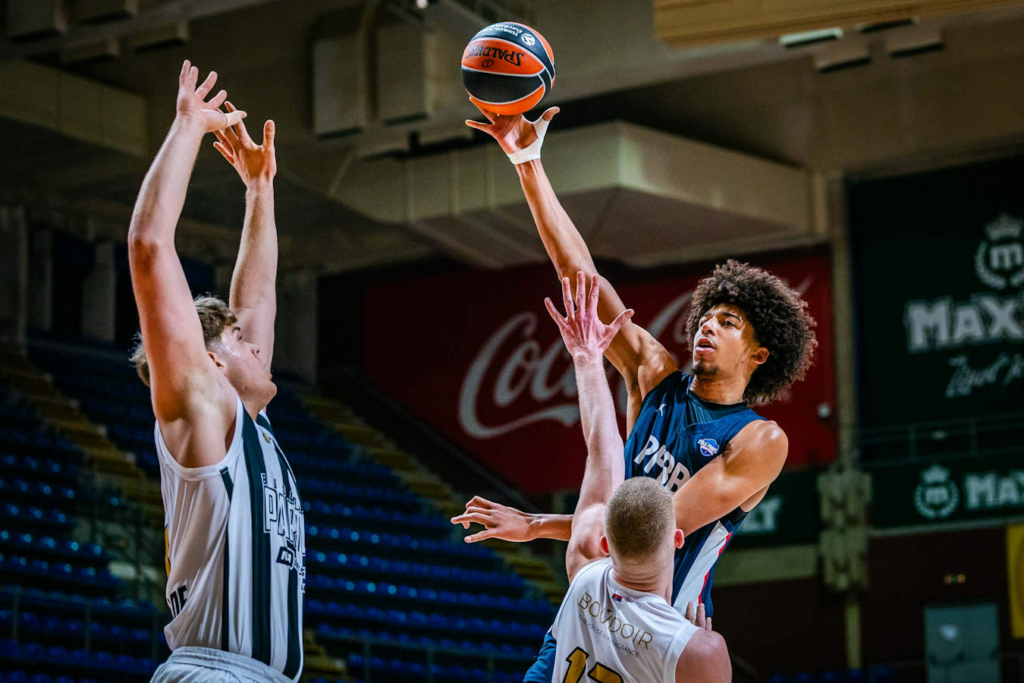
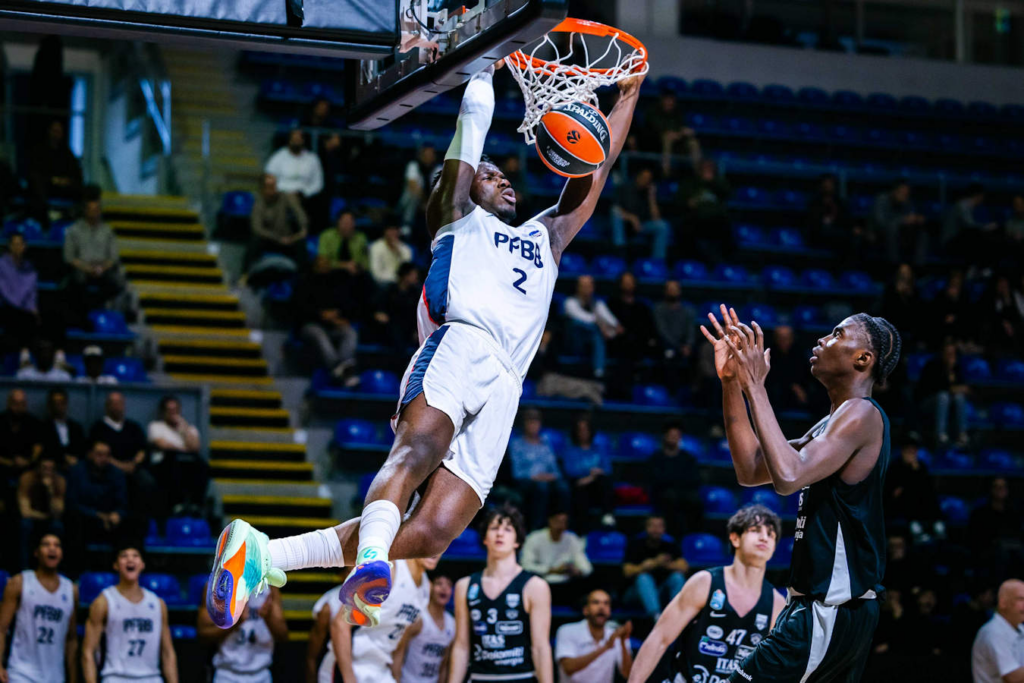
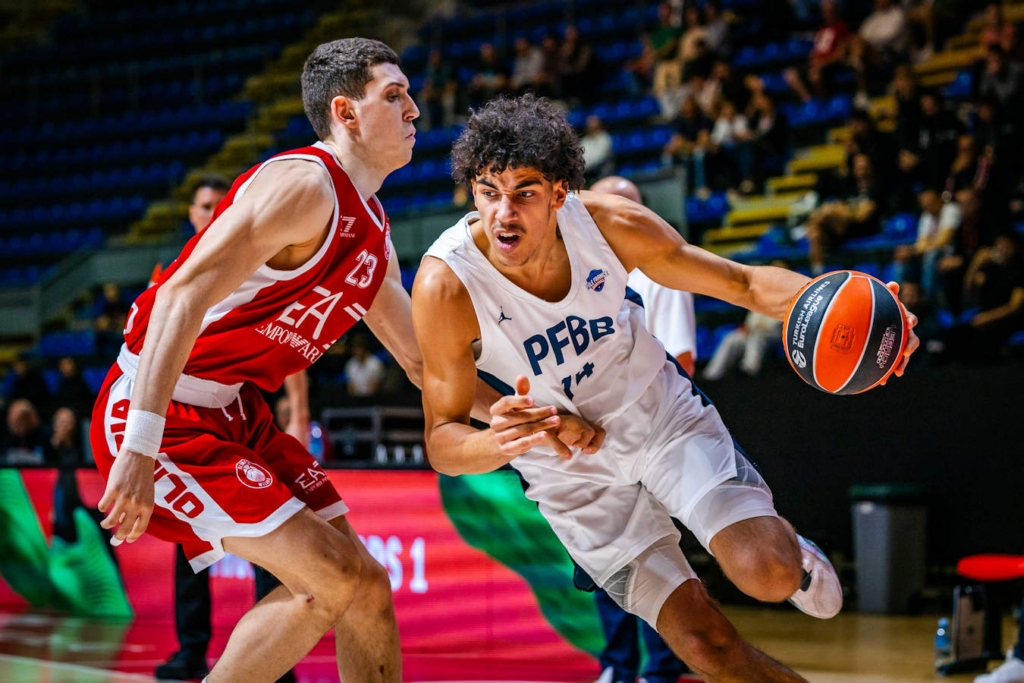
2009-born Nathan Soliman is a name to closely monitor throughout the season and in future tournaments. Soliman has the profile of a high-potential two-way player, boasting elite physical tools — positional size, a strong frame, length, mobility, and athleticism. The French prospect averaged 11.2 points (68.2% 2P, 27.3% 3P on just under 3 attempts per game), 5.5 rebounds, 1.8 assists, 1.2 steals, and 0.5 blocks per game. He was highly effective attacking the rim off the catch, using his explosive first step to beat defenders with both hands, both along the baseline and when cutting inside. What set Soliman apart in this tournament was his expanded offensive role. He handled the ball more frequently, running plays as the primary ball handler in pick-and-roll situations. Soliman showed the ability to create for both himself and his teammates, reading and reacting effectively to different defensive situations. He demonstrated solid mid-range scoring ability and finished the tournament with 7 assists — matching his combined total from the Paris qualifier and the Finals in Berlin — while maintaining a low turnover rate of just 1.2 turnovers per game. Defensively, Soliman reinforced his value as a versatile defender, capable of guarding multiple positions. His combination of size, quickness, and defensive awareness provided valuable flexibility for his team on the defensive end.
Two more standout performers from the NextGen EuroLeague qualifier in Belgrade were Matthys Mahop and Cameron Houindo. Houindo proved to be a highly effective two-way player, displaying a high motor and consistent energy on both ends of the floor. His strong frame, wide shoulders, and good athleticism round out his impressive physical profile. A true team player, Houindo contributed in multiple facets of the game, excelling as an efficient interior finisher. He demonstrated the ability to finish through contact at a high rate and attacked the basket with purpose. His off-ball movement and ability to set solid screens made him a valuable asset in the half-court offense. Defensively, Houindo showcased his mobility, basketball IQ, and length to cover space effectively and provide strong help defense. His awareness allowed him to disrupt passing lanes and contest shots consistently. Houindo finished the tournament averaging 12 points (54.3% 2P, 20% 3P, 50% FT), 5 rebounds, 1.2 assists (for 1.8 turnovers), 2 steals, and 0.8 blocks per game — a well-rounded and impactful showing. Mahop impressed with his positional size, length, and dynamic explosiveness. He brought great speed and intensity to the game, making an impact on both ends of the floor. Mahop delivered an all-around performance, averaging 7 points (41.2% 2P, 25% 3P on one attempt per game, 84.6% FT), 4.2 rebounds, and 4.2 assists (for 2.5 turnovers) per game. Offensively, Mahop showed solid court vision and good decision-making, creating open looks for his teammates and maintaining control in offensive sets. His quickness and ability to read the floor made him a valuable playmaker. Defensively, Mahop leveraged his agility and quickness effectively, showing strong on-ball defense and good anticipation off the ball. His ability to stay in front of quicker guards and contest shots added to his defensive versatility. – Theo Anastasoudis
EA7 MILANO
The Belgrade stop solidified Olimpia Milano’s 2007 generation as one of the most exciting groups to watch in European basketball, thanks to their skill, offensive firepower, and versatility. Diego Garavaglia continues to build serious momentum as an intriguing two-way wing: after making a strong impression in San Francisco, he carried that success into Belgrade, where his high-level impact on both ends earned him All-Tournament Team honors thanks to his versatility, defensive motor, and growing offensive craft. His ability to attack closeouts with long strides and quick accelerations allowed him get downhill with ease in order to finish with 12.5 points, showing off his vertical pop and body control at the rim. He also kept the offense flowing with 4.2 assists per game. Where Garavaglia truly separated himself was on the defensive end, showcasing switchability, length, and high-level anticipation to guard multiple perimeter spots. The 3 steals per game enforced his ability to jump passing lanes and disrupt opposing offenses, while his defensive rebounding was another key aspect of his game.
Achille Lonati continued to cement his reputation with his toughness, mobility, versatility, and high-level understanding of the game: his 3&D archetype is evolving, with signs of on-ball development to be a more dynamic offensive weapon while maintaining his defensive edge. He now operates with full confidence in his shooting ability, knocking down shots on all three levels – whether spotting up, pulling up off the dribble, or creating in one-on-one situations, with his 15.8 points per game reflecting his growing ability to self-create. His impact as a secondary pick-and-roll operator, converted in 3.2 assist per game, kept the tempo high for a fast-paced offense. Despite the three-point stats (27.5%) being heavily skewed from the cold 2/14 vs INSEP, he’s still threatening for every perimetral match-up: his shooting form, confidence and fire volume suggest that his percentages will trend upward with improved shot selection and consistency. His lockdown defense still enhance his two-way value against guards and sturdy wings, keeping the stance with grit, attention and high-level engagement. His expanding offensive game, stabilizing three-point impact and defensive intensity align well with modern basketball trends for 3&Ds with secondary playmaking upside.
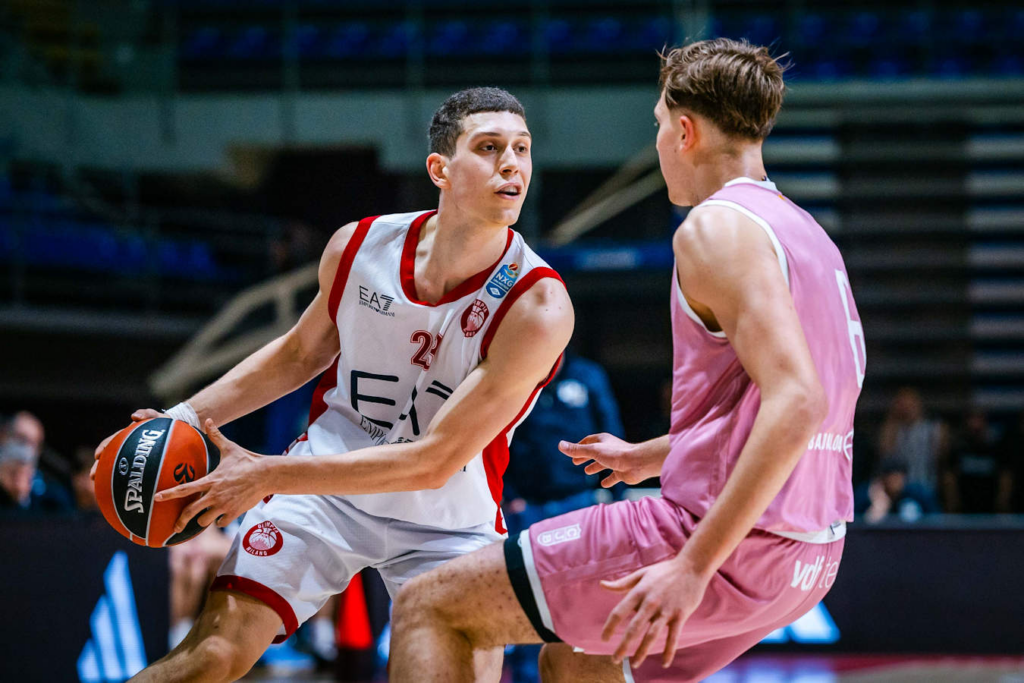
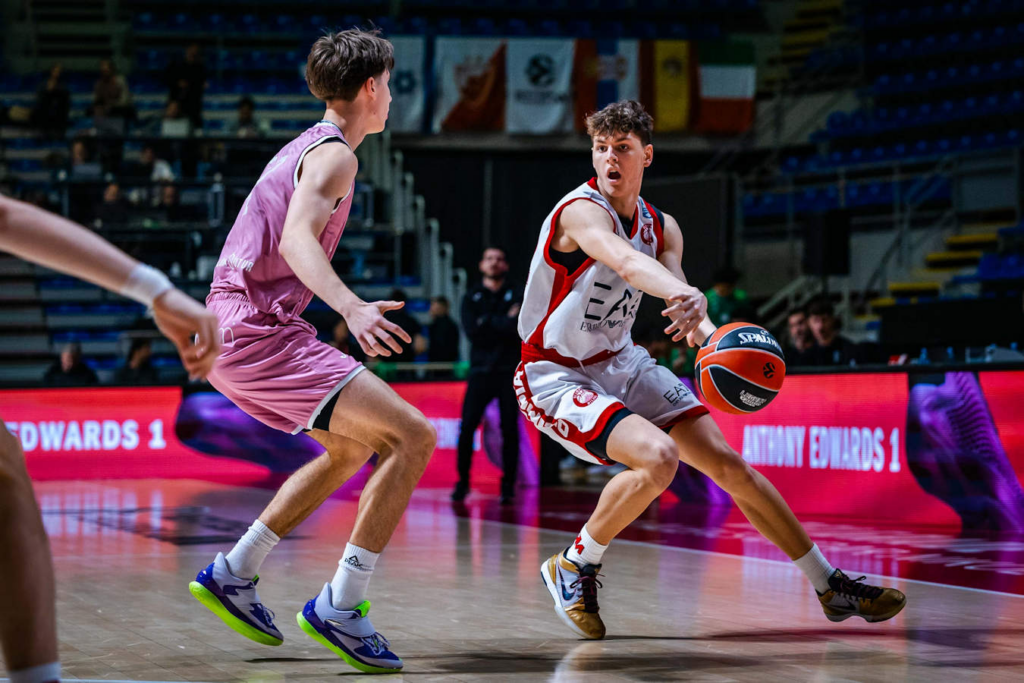
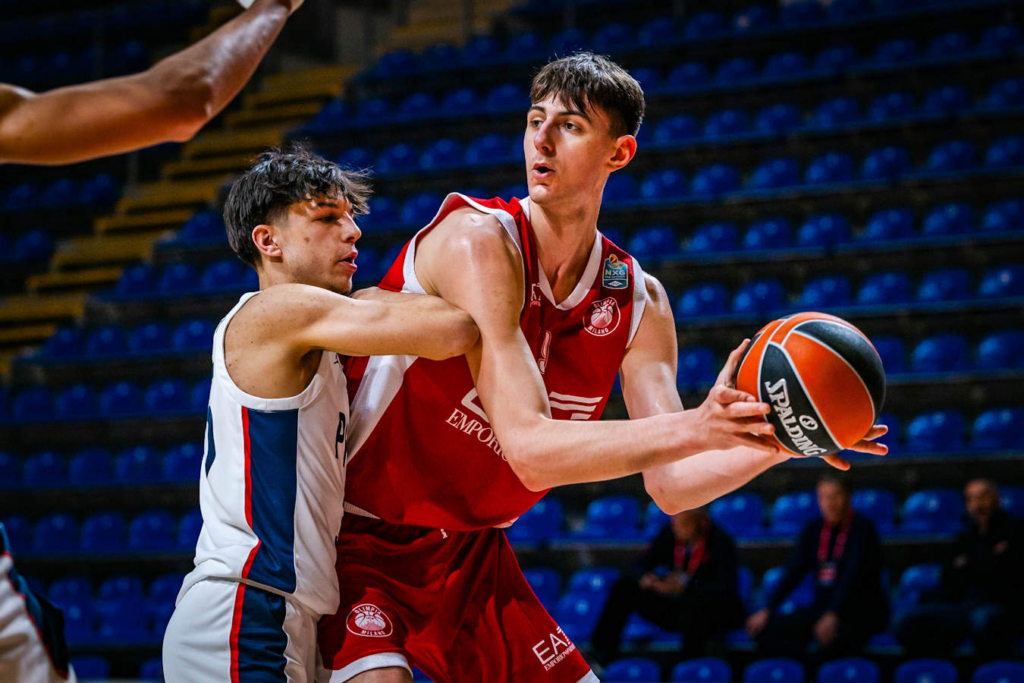
Luigi Suigo showcased significant strides in self-confidence throughout the tournament, stringing together a series of dominant double-doubles (with the exception of the final). Averaging 12.5 points and 11.2 rebounds per game, the towering 7’3 big man displayed a soft touch around the rim and an increasingly impactful presence on the boards. His post-game is evolving, showing improved comfort finishing with a hook shot or using the glass at sharp angles. His 50% field goal percentage reflects a key development – he’s becoming more adept at cleaning up his own misses, while his efficiency as a finisher still needs refinement to become a freakish force in the paint. Also flashed some stretch potential (2/8 beyond the arc): while the percentage wasn’t great, his shooting mechanics and natural touch hint at a workable outside shot that could add consistent floor spacing to his craft. Plus, he stayed consistent with 1.8 blocks per game due of his wide wingspan. He also proved to be disruptive in passing lanes while dropping in pick-and-roll (2.2 steals per game), using his length to create deflections and force turnovers. However, he still has a tendency to get caught up in over-aggressiveness, committing unnecessary fouls – something that needs to be cleaned up to ensure his minutes on the floor, given his importance in the lineup.
In the end, Mattia Ceccato is rapidly gaining attention as an intriguing backcourt prospect out of Italy. The 6’5 guard has taken a major leap over the past year, and his performance in Belgrade only solidified his trajectory as a versatile on-ball creator with a modern frame and a natural feel for scoring. Averaging 13.5 points per game, he blends a fluid perimeter game with the ability to operate effectively, especially in pick-and-roll situations. Whether it’s finding the roll man, driving and/or kicking out, or creating separation for pull-up jumpers, his decision making pops. The latter is probably the most striking point of his craft, as proved by his 51% FG that speaks well of his smooth shot-making ability, particularly from mid-to-long range. Beyond his scoring, he brings a steady presence both on and off the ball, showing leadership traits and a strong understanding of offensive flow, with 3.8 assists per game. There’s still work to be done in terms of defensive physicality and overall awareness, but his length, motor, and competitive nature lay a strong foundation for perimeter defense and one-on-one matchups. His engagement from the bench and vocal presence on the floor further reinforce the leadership potential for this multi-level scoring guard who could carve out a role at higher levels of competition. – Federico Gaibotti
NEXT GEN SELECTION
The Next Gen Select Team delivered one of the best games of the tournament against INSEP, but ultimately fell short, missing out on a spot in the Final of this qualifier. The standout performer for the Next Gen Team was none other than Aaron Towo-Nansi. Despite playing two years up and standing at just 5’9″, Towo-Nansi had no trouble dominating throughout the qualifier. He averaged an impressive 20.5 points (46.9% 2P, 38.5% 3P on 6.5 attempts per game, 84.6% FT), 2.8 rebounds, 4.2 assists (with just 2 turnovers), and 3 steals per game – earning himself a well-deserved spot in the All-Tournament Five. Towo-Nansi’s game was defined by his aggressive scoring mentality and playmaking ability. A true score-first point guard, he displayed excellent explosiveness when attacking the basket, with remarkable acceleration and a sharp change of pace and direction. His ability to create separation and capitalize on his quick moves made him a constant threat. He maintained outstanding shooting splits, combining effective drives to the basket with off-the-dribble pull-ups from behind the arc, showcasing impressive shooting range. Even more impressive was his defensive impact. Towo-Nansi put relentless effort into defense, showing no fear of physicality and initiating contact when necessary. His active hands, sharp positioning, and ability to disrupt passing lanes resulted in consistent steals and defensive stops. His ability to pressure the ball handler and create turnovers rounded out an all-around standout performance.
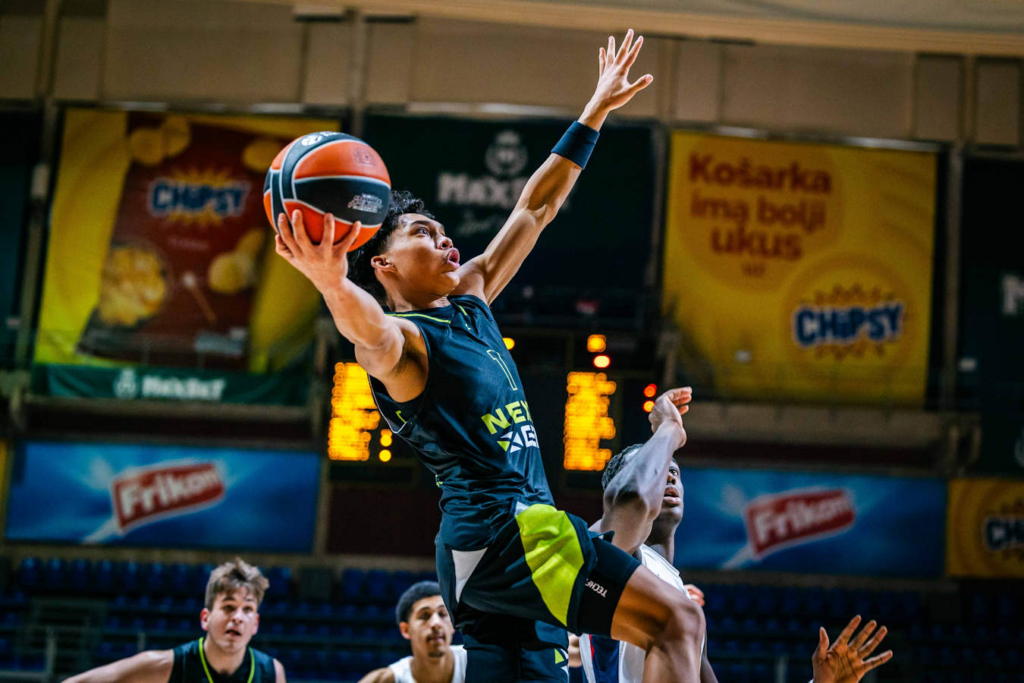
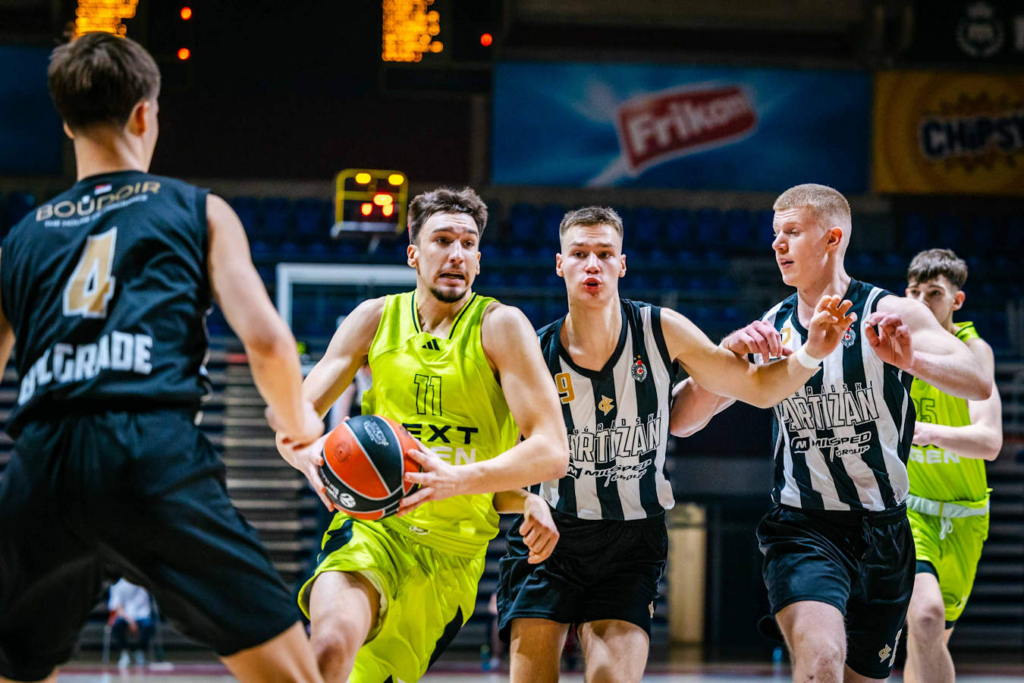
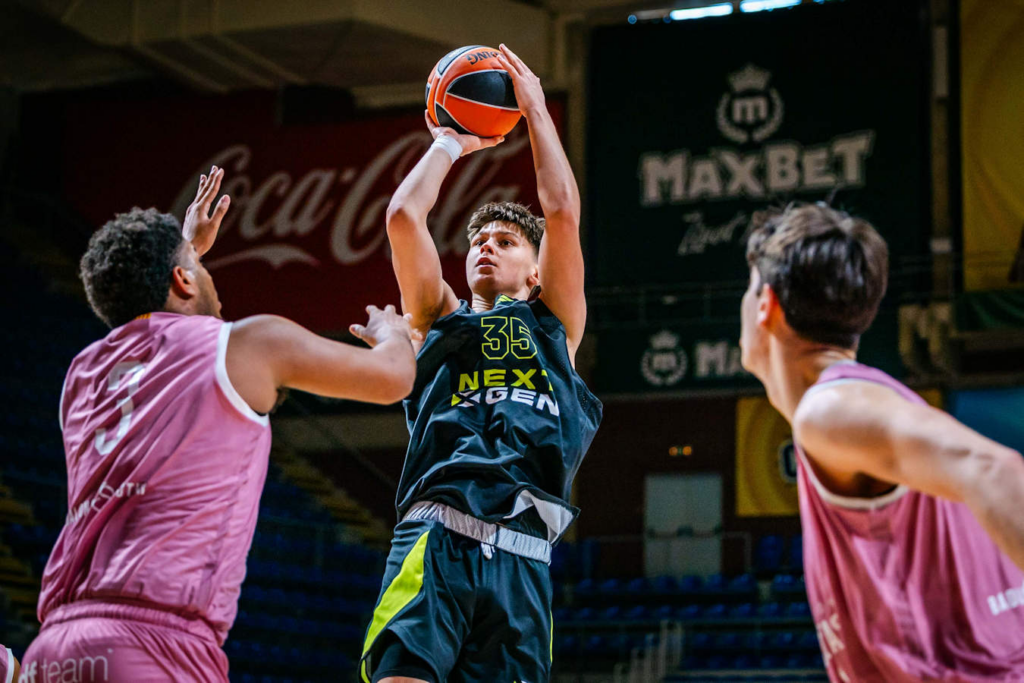
Kaur Tomann made a solid contribution, averaging 11 points (63.2% 2P, 30.8% 3P on 3.25 attempts per game, 72.7% FT), 3.5 rebounds and 1 block per game. A skilled big man with a strong motor and physical presence on both ends of the floor, Tomann demonstrated a versatile and efficient offensive package. He attacked the rim effectively, showing high efficiency both from the post and as a slasher – an area where he displayed intriguing potential. Tomann wasn’t hesitant to take shots from the perimeter, showing a decent volume for a big. While his outside shooting was respectable, improving his consistency and making slight adjustments to his shooting mechanics could elevate his game further. His ability to combine interior scoring with perimeter shooting makes him a versatile offensive weapon with room to grow.
Another intriguing forward for the Next Gen Select Team was 6’6 Borna Katanovic, who played a key role in his team’s efforts throughout the tournament. Katanovic averaged 9.8 points (69.2% 2P, 33.3% 3P), 4.8 rebounds (including 2 offensive rebounds), 2.5 assists and 2.2 steals, while averaging 25:28 of playing time per game. The Croatian forward delivered a well-rounded and versatile performance, contributing effectively on both ends of the floor. His defensive impact was particularly impressive, as he consistently applied pressure, recording 2.2 steals and 0.5 blocks per game. Offensively, Katanovic showed the ability to attack the rim effectively. While his perimeter shooting was limited during this tournament – attempting only 3 three-pointers across 4 games – he has demonstrated better range, higher volume, and improved efficiency in other competitions. His ability to adapt and contribute across multiple facets of the game highlighted his versatility and value to the team. – Theo Anastasoudis
JOVENTUT BADALONA
A 4th place finish for a Joventut team with a clear-cut star but also a lot of promising youngsters around him. With a 2-2 record, the Spanish team started and finished with losses in games that got out of hand all of a sudden, despite a good response both times. Ian Platteeuw was part of the All-Tournament Five with an impressive average of 16.2 points, 15 rebounds (7.2 offensive), 4.2 assists and 1.5 steals. The 6’11 big was the go-to guy for Joventut, using his size and post creation every time down the floor. Be it on pick and rolls or creating around the paint, his touch around the basket and advanced court awareness and vision put opponents in check and cemented Platteeuw’s status as one of the best bigs in Europe. The efficiency wasn’t at the expected level – the volume may have impacted that, as well as a difficult start against Milano – and the rim protection is still below what it could be, but there’s no doubt that he is one of the most intriguing centers of his generation, with a feel for the game that isn’t common at his age. His passing was what stood out the most, finishing third in the qualifier. And it’s not like he’s only able to deliver the ball to his teammates off a standstill position – even if that part of his game would’ve been special by itself. He’s capable of putting the ball on the floor and attack or read plays quickly off the short roll, hitting teammates moving behind the defense or spotting up outside.
Eric Del Castillo looked much closer to the energetic slashing off-guard many predicted he could become a few years back. Finished at a 53.1% clip from two and 75% from three (one attempt per game), mostly as a cutter or closeout attacker, finishing the Belgrade window with 11.5 points, 2.2 assists and 1.2 steals. His speed and agility as a driver were on display as he tried to initiate offense quickly off steals or finding pockets of space within Joventut’s ball movement. At 6’6, his defense was intriguing even if a bit inconsistent. He proved his ability to stay in front of ball handlers but especially chase wings off the ball, avoiding screens and keeping the pressure on the opposition. He’s extremely fluid in his movement on both sides off the ball and a great weapon to have exploring seams that the opposition leaves.
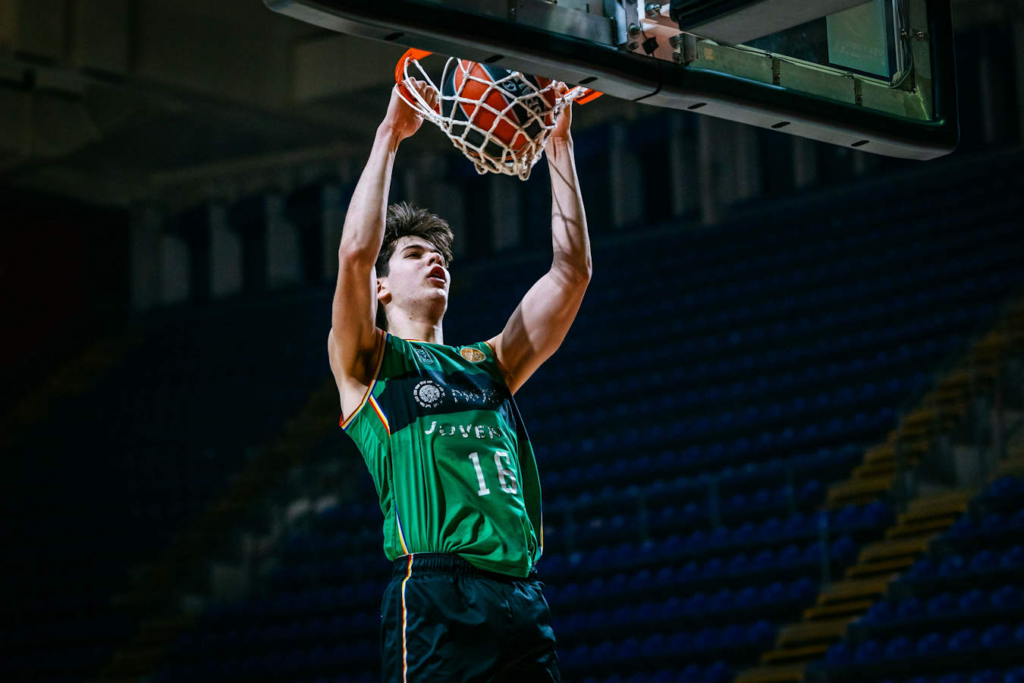

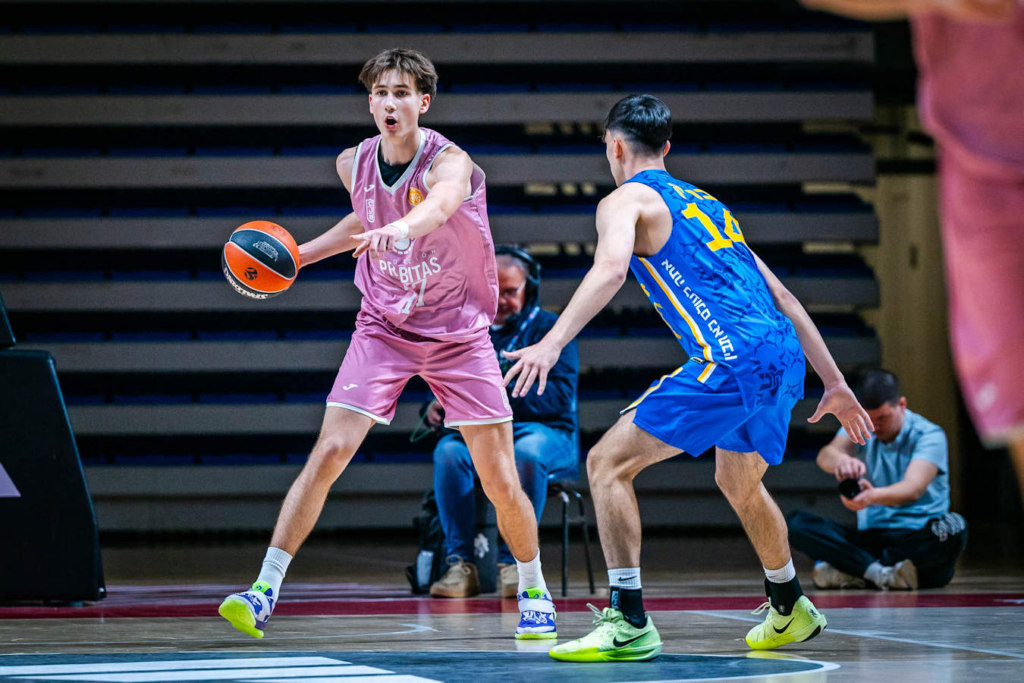
Helmuts Petrovics was one of the biggest revelations of the Belgrade qualifier as a shot creating handler and initiator for the Badalona team. A bit of a do-it-all guard at 6’4, his most impressive trait proved to be his playmaking. In a team that moves the ball, Petrovics shined with quick decisions on the move, able to predict plays before they fully unfold or get inside and force the help before kicking the ball out. At 10.5 points, 4.2 rebounds, 7 assists and 1.5 steals per game, he was a big contributor on the offensive end. The efficiency didn’t keep up with the volume, but the Latvian’s ability to find solutions as a driver and provide shooting off the catch can’t be overlooked. Interesting player to continue following. Humberto Ruiz was one of the youngest players in attendance, fresh off his 16th birthday. But that didn’t put a stop to his willingness to start making a name for himself on the biggest stage in Europe for young players. A lanky 6’5 wing who’s still growing into his body, Ruiz provides rim attacks at about the same rate he shoots the ball, with impressive efficiency for his age – 53.3% from two, 36.4% from three. More of an off-ball player who’ll look to either attack or pull the trigger off the catch, he showcases some qualities as a driving creator and a player who knows how to get to the free-throw line at such a young age, while keeping the ball moving on the perimeter. Uses his length and fluidity as an athlete to be an effective defensive piece, both on and off the ball. Finished the Belgrade qalifier with 8.5 points, 2.2 rebounds, 1 assist and 2.2 steals a game.
Terence Kekenbosch took part in just two games, but was still able to provide a spark for his team with his offensive arsenal. Capable pick and roll handler with a tight handle and quickness of movement, allowing him to beat defenders from the perimeter or gain space behind the line. A performance that left fans and scouts wishing for more as he only played against the two best opponents Joventut faced, but with an average of 11 points per game and a bit above 57% from two, a great sign for a player who had a tendency to go for forced threes a bit much. 6’6 Saba Merebashvili continues to improve and display his quality as a 2008-born player with an outstanding physical profile. 7.8 points, 4 rebounds, 1.2 assists and 1 steal per game, while shooting 58.8% from two. An off the ball finisher, looks to attack behind the defense and discover open spaces in the opposition to explore as a driver or cutter. Leaks out early to finish transition plays, with a good frame to withstand contact and finish. Shot below 30% from three, but with less hesitation and a quicker shooting motion, proving the work he is putting in to develop that part of his game. – António Dias
CRVENA ZVEZDA BELGRADE
After a blazing start, the hosts lost the chance to compete for a spot in the tournament’s top four. However, some prospects still showcased flashes of talent. Starting off with Stefan Marjanovic, a heavy-footed but still growing 6’11 big with floor-spacing ability and a mix of size, shooting touch, and flashes of offensive versatility. Owner of solid length to contest shots and disrupt passing lanes, even if lacking elite verticality. He can knock down standstill threes with solid mechanics, particularly as a pick-and-pop option as confirmed by his 50% behind the arc. Despite being somewhat mechanical, he has enough control to execute post moves through spinning and hook shots, leveraging his size against positional peers. Showed glimpses in facing slower bigs from the perimeter, being capable of finishing at the rim when given space. Essential steady cornestone in Crvena Zvezda’s offense, as his 17.8 points per game proved. His evolution as a stretch player should come with solving the mobility concerns in verticality, fluidity and laterality, especially on the defensive end.
A key point in the tournament for Crvena Zvezda, Lazar Stojkovic’s craft was highly impactful on both sides. At 6’10 with a strong lower-body and a developing frame, he possesses natural size for a modern frontcourt player. Despite not being explosive vertically or quick-twitch mover, he relies more on positional play, being able to exploit his length. As a secondary offensive weapon, he thrives in structured offensive sets primarily as standstill shooter in pick-and-pop and shows flashes as a short-roll facilitator. While not a dynamic shot creator, he makes sound reads and keeps the ball moving within the flow of the offense. His 13 points per game reflect his ability to capitalize on clean looks. His unusual 4.5 assists per game can help compensate for some shortcomings in his game: he understands spacing and ball movement as a connector piece, capable of making the extra pass and recognizing defensive breakdowns. He proved to be a positional defender who can impact the game through size and awareness rather than elite mobility. His foot speed is a liability in space, making him exploitable in pick-and-roll coverages that require hard hedges or switches.
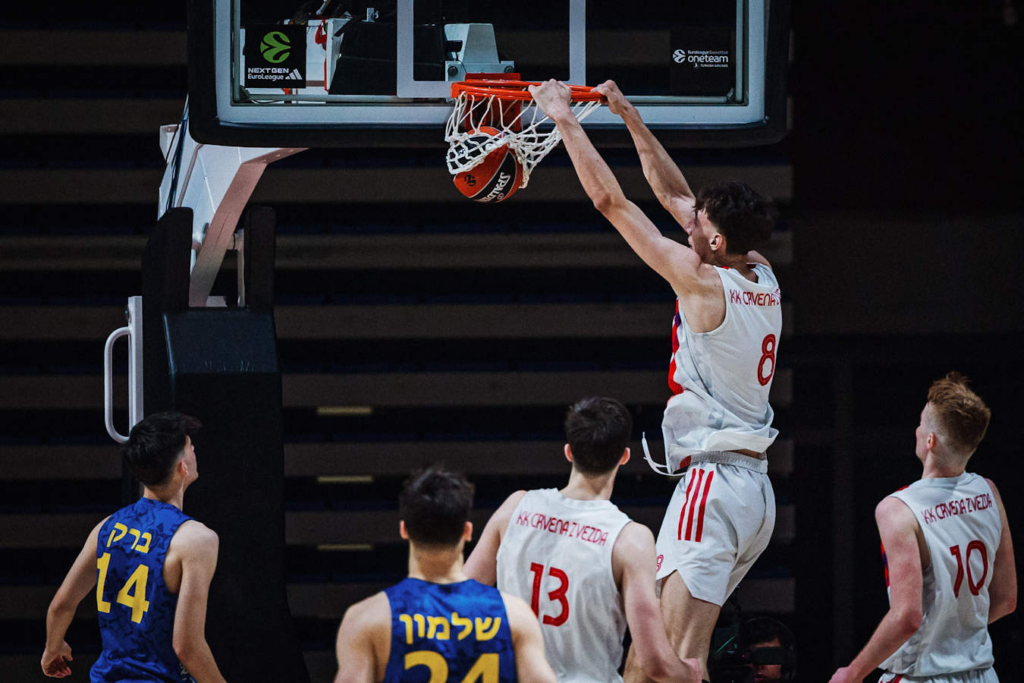
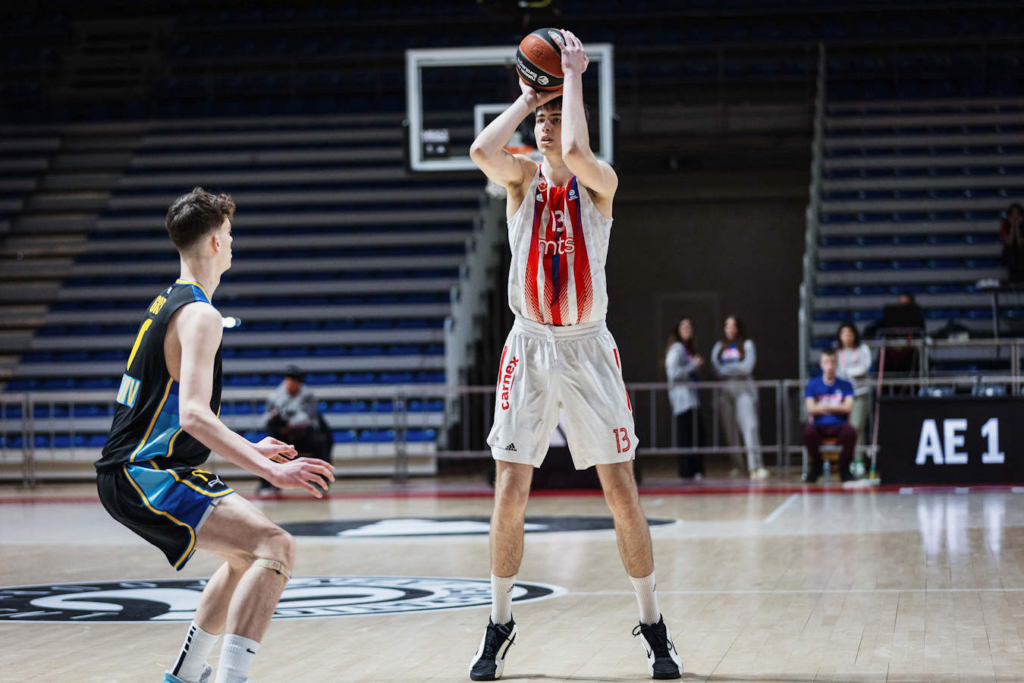
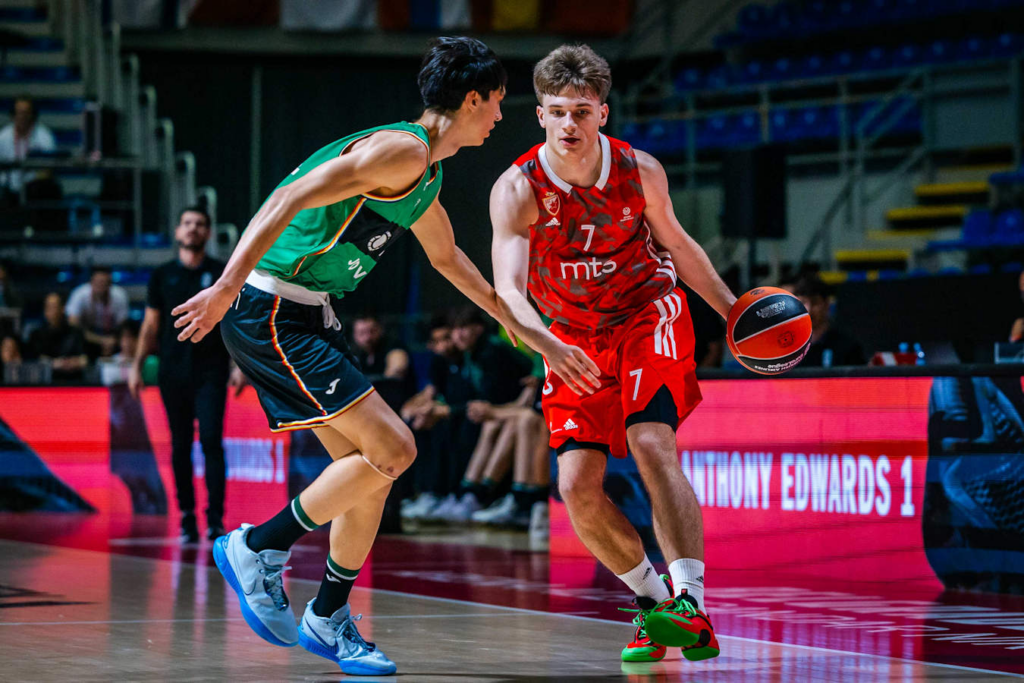
Andrej Lucic confirmed his hungry scorer mentality with 12.5 points per game: an aggressive guard with high motor, this 6’2 handler thrives on changing pace and attacking downhill. He plays with relentless energy and looks to impose his will offensively, particularly in isolation and mismatch situations. He can be effective from mid-range when given space, especially off step-backs or self-created looks and his mechanics hold up well when uncontested (50% inside). Plays with an edge and doesn’t shy away from contact. Uses his body to create space but lacks the balance and control to consistently convert through traffic. However, his game remains unpolished in terms of decision-making and efficiency, and he tends to force the issue rather than let the game come to him. His shooting consistency is quite limited, with tunnel vision at times, often prioritizing his own offense over keeping teammates involved. Engages physically on-ball and applies tight defensive pressure, although over-aggressive in spurts.
However the most intriguing upside in Crvena Zvezda roster is Jovan Bikic, a 6’7 swingman who is a tough, system-oriented player who plays with energy and purpose. Plays with no fear when driving to the basket, using his frame to shield defenders and finish plays, either scoring at the rim or making smart kicking the ball out. Comfortable and selective on off the catch shots – 60% on low volume – his solid form can benefit from a quicker release. While not a primary ball-handler, he is capable of making plays as a second-side creator: his decision-making is sound, and he operates effectively within a team-oriented offense (3.2 assists per game). However, he cannot generate significant advantages off the dribble, relying more on teammates to create opportunities for him. Not a high-usage player, but plays with noticeable grit and character, engaged on both ends of the floor, with a strong will to do the little things that impact winning. Active and engaged defensively, needs to improve lateral quickness and anticipation to become a more disruptive defender. – Federico Gaibotti
PARTIZAN
Partizan finished in 6th place after falling short to Crvena Zvezda (67-75) in the 5th place game. The team from the host city of this NextGen qualifier ended the tournament with 1 win and 3 losses. Lukas Nikola Bojovic led his team in scoring, averaging 15.5 points (71.4% 2P, 42.9% 3P on 4.5 attempts per game, 87.5% FT), 2.3 rebounds, 1.7 assists (for 3.7 turnovers), and an impressive 3.3 steals per game. Bojovic showcased strong scoring instincts with room for growth and refinement. He demonstrated smooth mobility and a strong shooting ability, particularly from behind the arc, both off the dribble and the catch. His standout performance came in the game against Trento, where he caught fire, hitting 6/7 three-pointers – including multiple consecutive makes after heating up early.
Daris Sijaric, an undersized center, used his strong frame and fluid mobility to create advantages in the post. He demonstrated soft touch around the rim and a strong ability to secure rebounds, especially on the offensive end, where he averaged 4.5 offensive rebounds per game. Most of Sijaric’s scoring came from the interior, as his outside shooting was limited. He finished the tournament averaging 13.5 points (45.5% 2P, 25% 3P on 1.2 attempts per game, 64.7% FT), 9 rebounds, 1.2 assists, 0.8 steals, and 0.5 blocks per game – further highlighting his effectiveness near the basket.
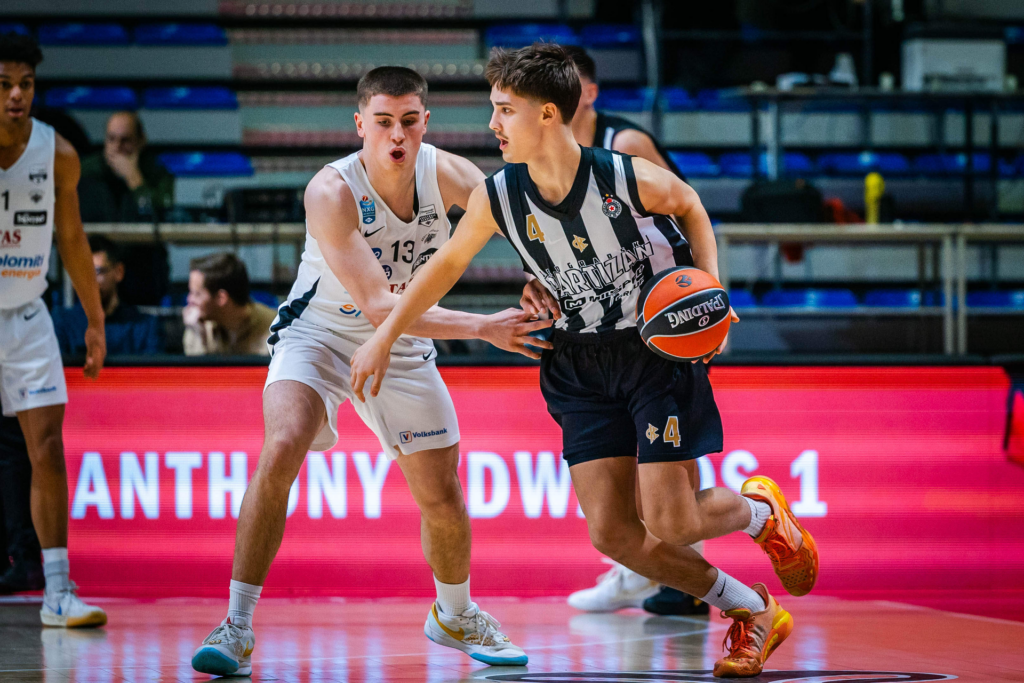

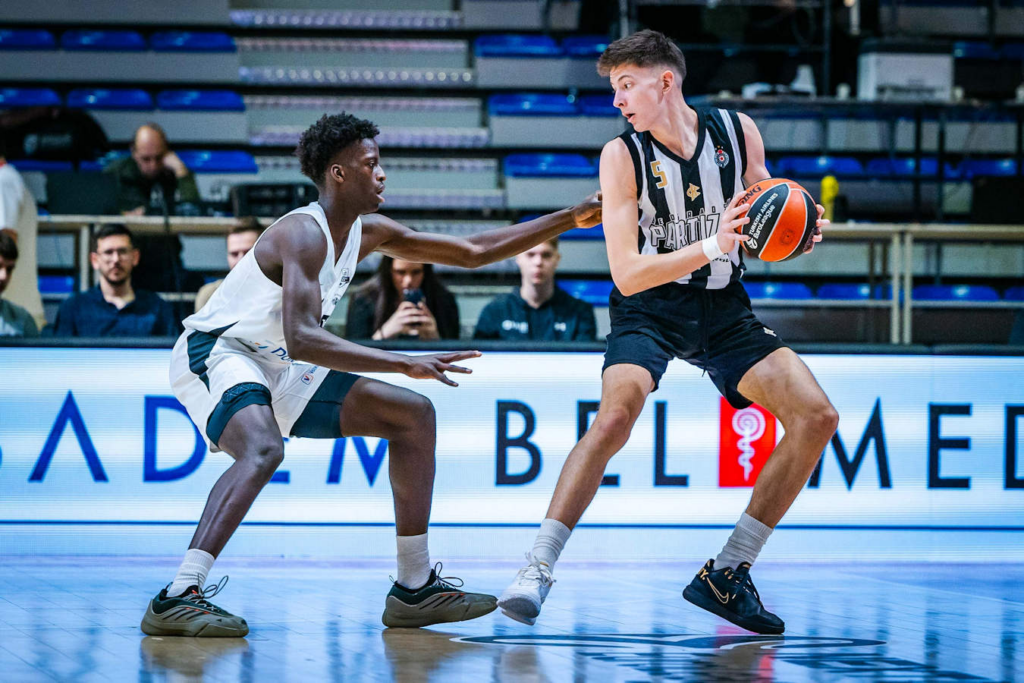
Stefan Isailovic possesses one of the most intriguing frames in the tournament for a guard, standing at 6’9 with a strong core and impressive length. He moved fluidly and provided valuable contributions on both ends, excelling particularly in defense due to his versatility and ability to guard multiple positions. Offensively, Isailovic showed glimpses of his scoring package but focused more on his overall contribution. He averaged 6.5 points (58.3% 2P, 30% 3P on 2.5 attempts per game, 100% FT), 3 rebounds, 2 assists, and 1.8 steals over 27 minutes per game across 4 games. Uros Danilovic was Partizan’s third-leading scorer, averaging 10.3 points (45.8% 2P, 14.3% 3P on just under 2 attempts per game, 75% FT), 4.7 rebounds, 1 assist (for 5.3 turnovers), and 1 steal per game. Danilovic’s physical profile is highly intriguing, with excellent positional size and solid scoring ability. He attacked the basket aggressively, showing creativity when navigating traffic and finding ways to finish at the rim. While his perimeter shooting was inconsistent, his ability to create scoring opportunities inside made him a valuable offensive asset. – Theo Anastasoudis
DOLOMITI ENERGIA TRENTO
First ever experience for the Italian squad, with the winning shot of Mario Machetti giving them their first win in the last match. The first name to mention is Cheickh Niang, a raw but explosive athlete. Niang is an intriguing 6’4 long-term prospect due to his combination of quickness, strength, and downhill attacking mindset. He can use the glass cleverly with a nice touch inside, but his biggest swing skill concerns his off-dribble shooting: the form is still wavering and sometimes his selection is highly questionable. This can push him to develop a respectable jumper and refine his ball-handling to emerge as a two-way impact player thanks to his snakelike arms for flashy steals and eyecatching shot blocking.
Patrick Hassan blended his scoring craft and bucket-maker nature into the team offense producing 12.8 points per game. Capable of knocking down shots from all three levels, though his form still needs fine-tuning, his on-ball scoring still makes him a consistent 6’3 offensive weapon. He showed improvement in balancing his scoring instincts with playmaking for others: his on-ball gravity and higher international experience opened up drive-and-kick opportunities to trigger his teammates, converting his ball sharing in 5 assists per game. He struggled a lot to find his space in traffic against lockdown defensive line-ups and causing lots of turnovers. 6’9 sturdy forward Cesare Placinschi had a solid showing, consistently making smart plays and maximizing his skill set despite not being an elite athlete. Lacking elite verticality, he compensates by attacking closeouts properly and is willing to take on contact at the rim. He’s capable of exploiting mismatches from the post, using patience and footwork to get quality looks. His game is solid across the board, his feel for the game and decision-making are promising, but his physical tools leave a question mark on his overall potential.
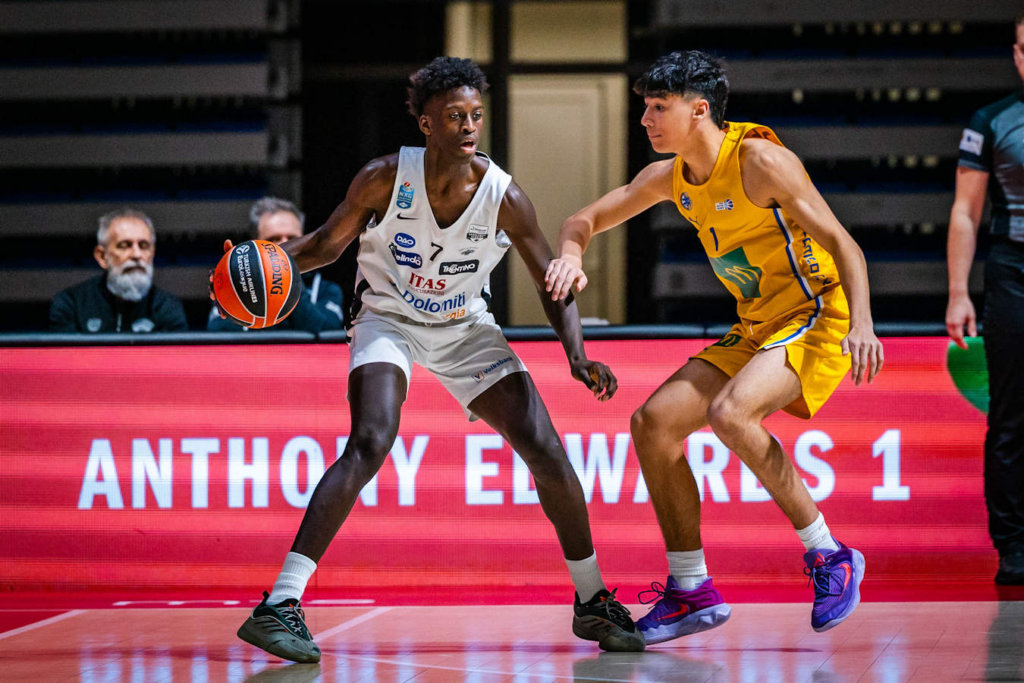
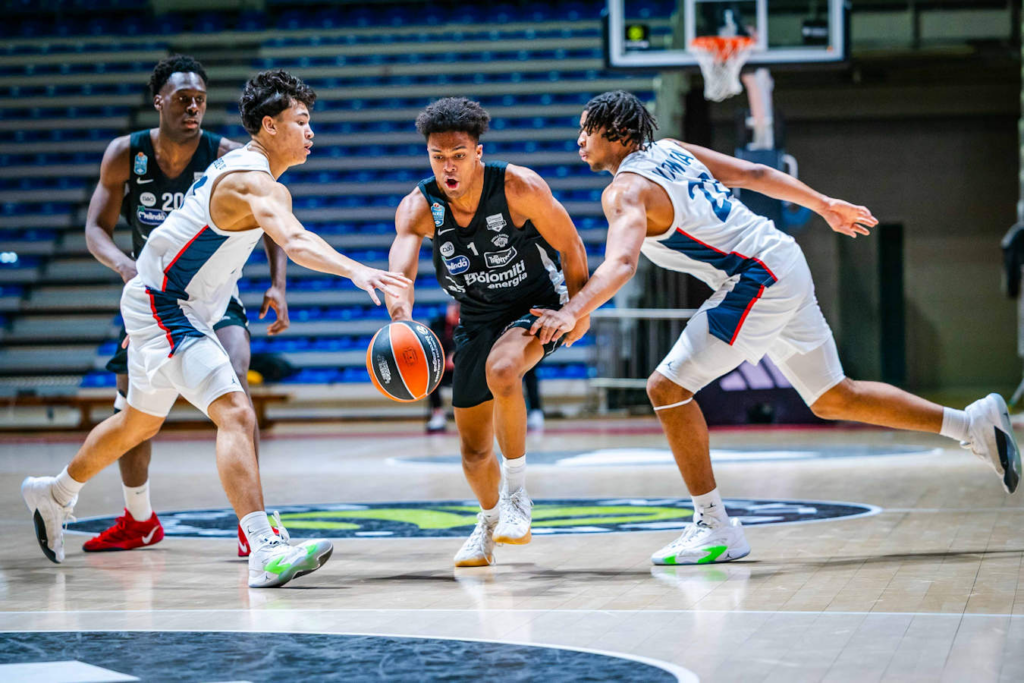
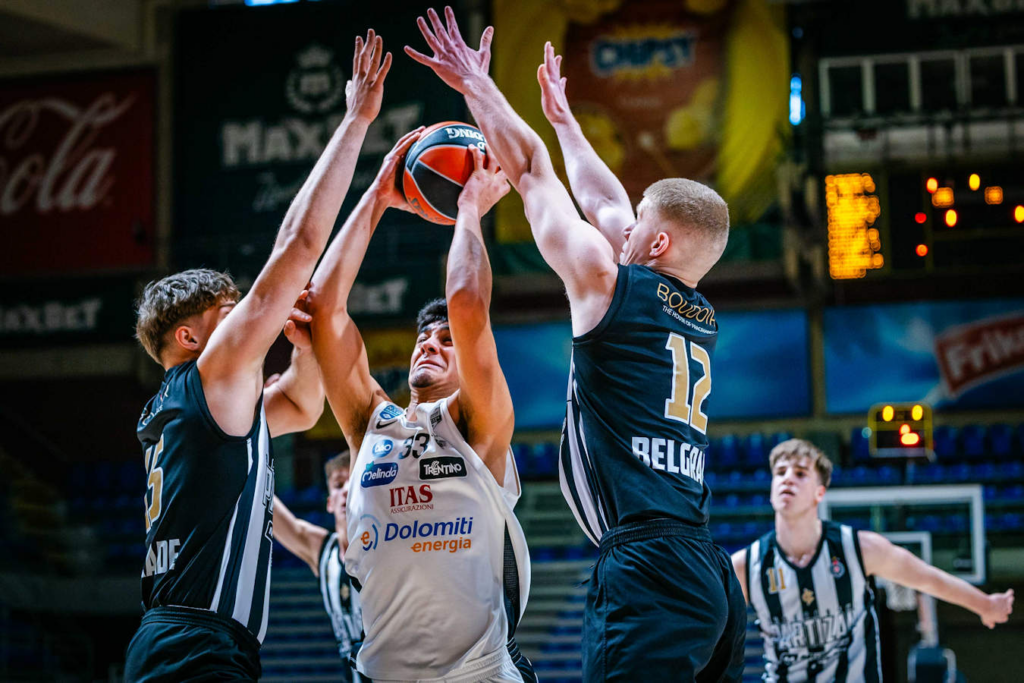
In the end, the two loans from Stella Azzurra, Valentin Curbelo and Prince Lumena had different fates to impose their basketball. The 6’6 guard from Uruguay kept his steady-handed primary ball-handler nature with solid positional size and a strong base, facilitating the game and keeping a tough and gritty perimetral defense. His shooting form is the major limitation, besides the lack of athleticism and offensive toughness. The 6’9 Congolese big showed more character with a bruising presence: an old-school post player who thrives on physicality, he was comfortable sealing deep and finishing with a hook shot, using his frame to carve out space. While he’s not overly vertical, his strength allows him to hold his own on both paints. Despite lacking rim protector skills, he does a solid job of contesting shots and battling for position. – Federico Gaibotti
MACCABI TEL-AVIV
A rather disappointing outing for a Maccabi team which saw their opportunity at a lone-win being stolen at the buzzer in the 7th place game. There were still some good things for the Israeli team to take away from this Belgrade iteration of the NextGen Euroleague qualifiers. 6’1 Arbel Lachmanovic kept the pressure on opposing defenses, with 9.8 points and 2.2 assists per game, shooting 41% from two and 40% from three, sprinkling in a good volume of trips to the free-throw line. Showcased two-level scoring, finding ways to get inside off pick and rolls or his own creation, while also shooting off the dribble when the defense sagged off. Not really a creative passer, his assists came more off his team’s ball movement offense, keeping the motion going or getting the ball to his teammates in early offense. Born in 2008 and on his NextGen debut, he should be someone to keep an eye on going forward as an offense creator and scorer.
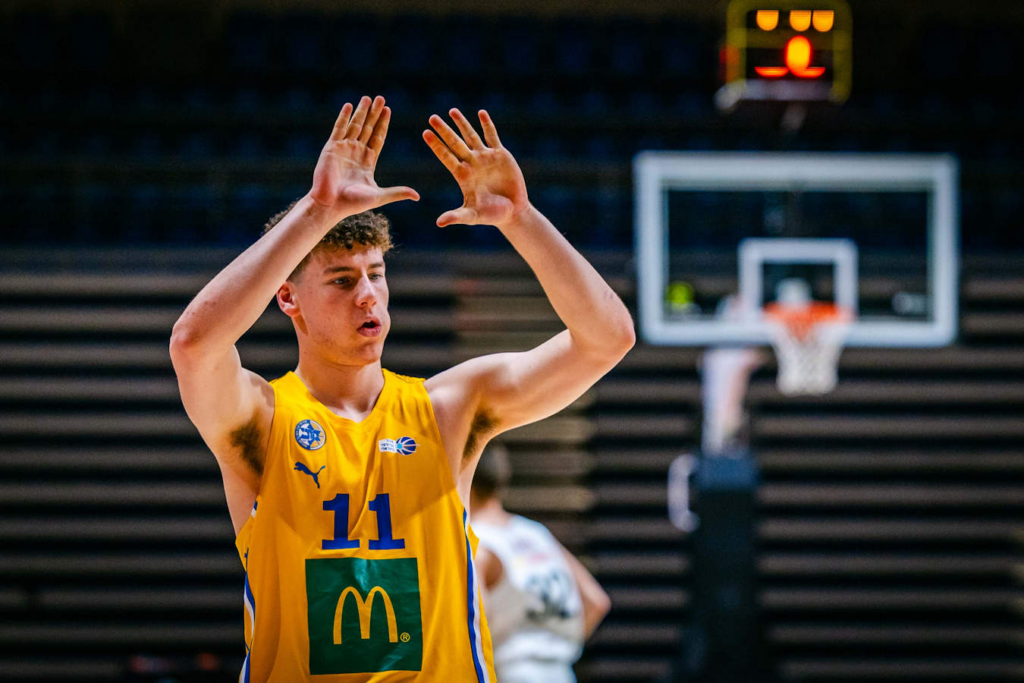
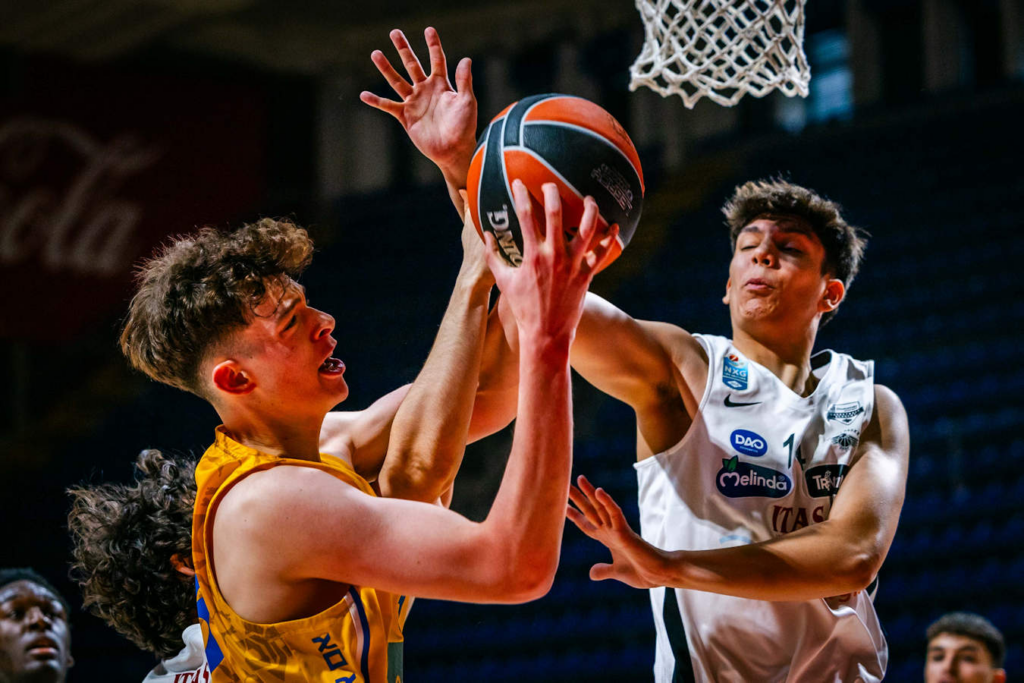
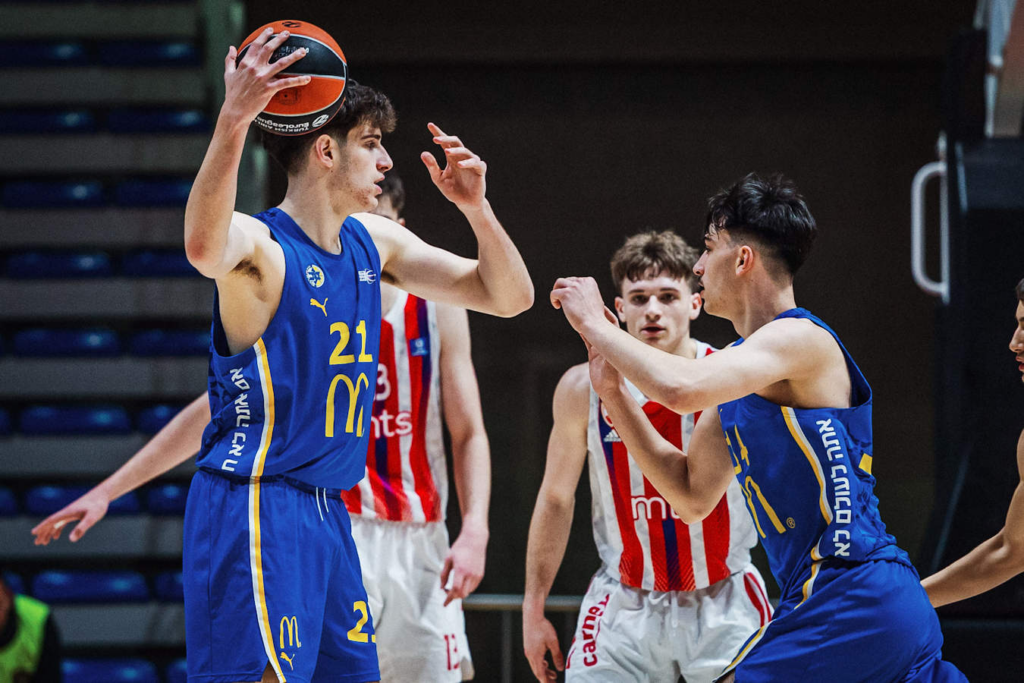
Along with Lachmanovic, the pairing of 6’9 bigs Tamir Gold and Gabriel Artmenko. Gold proved to be more of a mobile, stretch big who can use his agility and ability to move around, cutting behind the defense, creating from the low and high post and also shooting the ball, despite the low efficiency this time around. Showcased some ability to pass the ball, with good court vision and make plays all-around while providing defensive versatility on the other end. Artmenko plays closest to the basket, as a rim-finishing big, screening and rolling to the basket. Finished at a 59% clip from two in Belgrade, demonstrating some ability to put the ball on the floor and attack off the dribble, with good footwork in the post. With 1.2 assists per game, he found teammates when the defense keyed in on him and playing in tandem with Gold. – António Dias




















